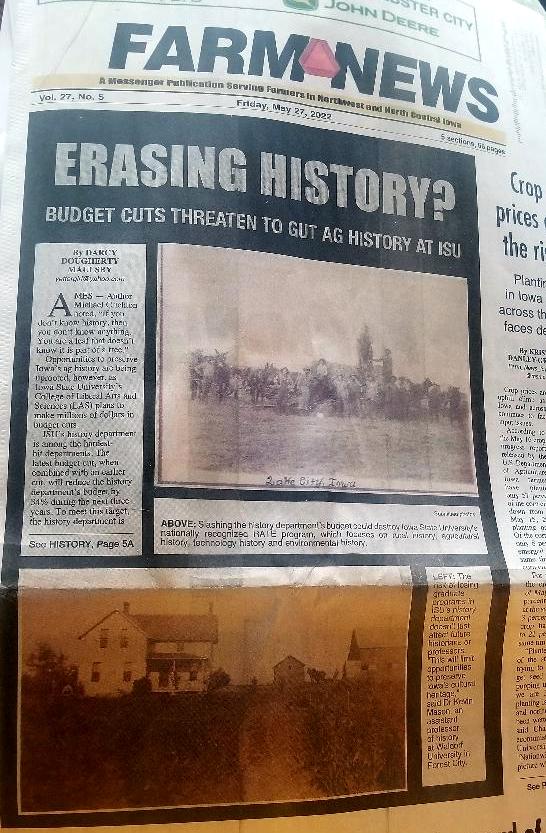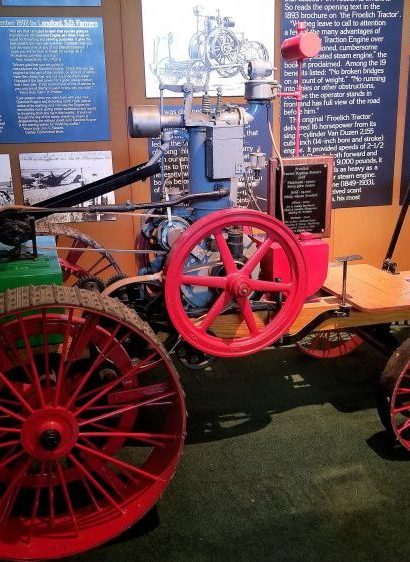
Whats HOT
Latest Posts
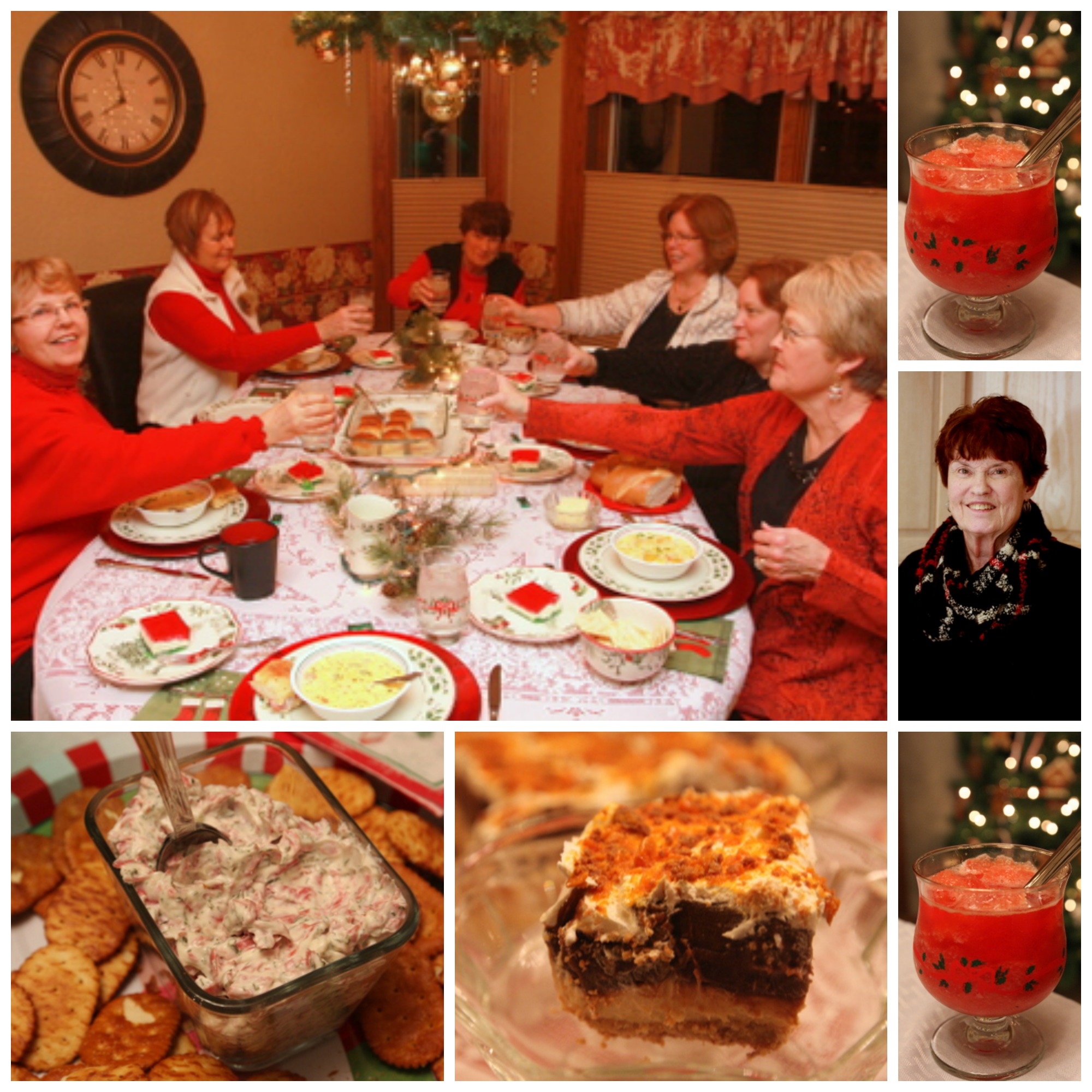
Shakespeare Club Maintains 123 Years of Good Taste in Small-Town Iowa
While one of Lake City’s oldest clubs likely wouldn’t have had any farm women for members when the group formed the 1890s, a farm wife (who is also my mom) is now the club’s president and has belonged to the group longer than any other member.

Jan Dougherty, Shakespeare Club president
“This was originally a very formal club where the ladies in town served white-tablecloth-style dinners and used their good china and silverware,” said Jan Dougherty of Lake City, president, who joined the Shakespeare Club in 1972. “Now we’re much more relaxed and just like to have fun.”
Part of the fun involves cooking classes, preparing homemade treats for the “lunch” following the meeting and sharing recipes. The group has visited Sweet Things Bakery in Lake City and recently enjoyed a cooking class taught by Robin Qualy of Lake City, who runs La Casa Cuisine and teaches people how to make homemade pasta and more.
“I like the camaraderie and enjoy getting to know people better through Shakespeare Club,” said Pam Feld of Lake City, who joined the group a few years ago.
Organized in 1894, the Shakespeare Club holds the honor of being the second oldest club in Lake City. It was organized by four young women interested in their social and intellectual advancement. Programs were arranged to study the lives and works of famous authors, although the greater part of each year was devoted to the works of Shakespeare. Later, the programs were diversified to include the study of music and the arts, as well as the cultures of Europe and South America.
During World War 1, Shakespeare Club members held benefit teas and auctions to raise money for the Red Cross. In the 1920s, a three-day celebration was held to commemorate the club’s silver anniversary. Parties, picnics, and a presentation of a picture to the library were part of the festivities. “The Shakespeare Club is famous for doing things right,” quoted the Lake City Graphic newspaper in 1923.
Through the years, club members have been instrumental in supporting the progress of schools and the local library, as well as civic improvements. As it has for years, the group continues to meet in members’ homes, and each meeting includes a program or special activity and ends with a luncheon.
“I like meeting in people’s homes,” said Pat Albright of Lake City. “It’s a comfortable feeling where we can be ourselves and enjoy each other’s company.”
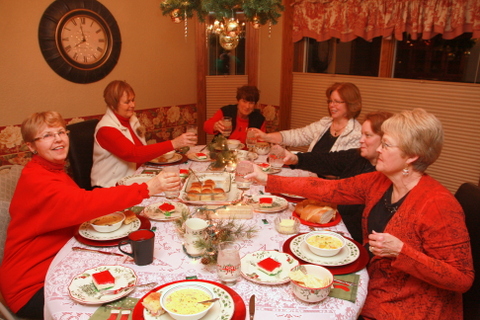
Members of Lake City’s Shakespeare Club enjoy homemade food and lots of laughs during this holiday celebration at Jan McClue’s home.
This also appeals to Jan McClue, who hosted the group’s 2016 Christmas party at her home near Lanesboro. “I like that we’re a group for fun, and I enjoy the interesting outings we go on around the area.”
One of the group’s favorite destinations is Studio Fusion in Fort Dodge, where members design their own glass picture frames, dishes, jewelry and more. No matter where they meet, however, snacks and homemade treats are always on the agenda. “Good food has always been part of Shakespeare Club, and I think it’s neat the club has lasted all these years,” Dougherty said. “Our motto could be, ‘We don’t meet if we don’t eat.’”

Darcy’s Corn Tortellini
Healthy Tortellini Corn Chowder
Smoky bacon combines with tender cheese tortellini for a creamy and comforting take on the usual corn chowder, which is one of my favorite soup recipes. I served it at the Shakespeare Club’s 2016 Christmas party at Jan McClue’s home near Lanesboro.
5 slices bacon
1 large onion, chopped
2 ribs celery, chopped
1 cup red, orange, yellow peppers, diced
2 cups fresh, canned or frozen corn kernels (about one and a half cans of canned corn)
2 cups chicken broth
1 cup sliced carrots
⅓ c unbleached or all-purpose flour or Wondra flour
3 cups 1% milk
⅓ cup chopped fresh basil, or 1 teaspoon dried basil
½ teaspoon salt
¼ teaspoon fresh ground pepper
8 ounces low-fat fresh or frozen cheese tortellini, cooked and drained
1 cup frozen green beans
1 to 2 cups diced ham, optional
Set a Dutch oven over medium heat. Add the bacon. Cook for 1 minute, or until it releases some of its moisture. Add the onion, celery, and bell peppers. Cook for 5 minutes, or until the vegetables are soft. Add the corn, broth and carrots. Bring to a boil over high heat. Reduce the heat to medium. Simmer for 15 minutes.
Place the flour in a medium bowl. Gradually add the milk, whisking until smooth. Pour mixture into the Dutch oven. Stir until well-blended. Add the basil, salt and pepper. Cook, stirring occasionally, for 3 minutes, or until the soup thickens. Add the tortellini, green beans and ham, if desired. Cook for 2 minutes, or until heated through.
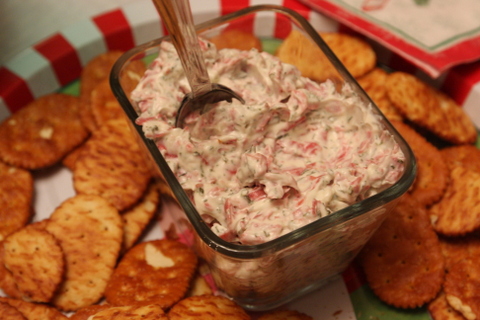
Jan McClue’s Beef Dill Dip
Beef Dill Dip
This tasty dip from Jan McClue is simple to make and can be served with bagel wedges or crackers.
1 16-ounce carton sour cream
2 tablespoons parsley
2 teaspoons Accent seasoning
2 packages dried beef, chopped
1 1 / 2 cup Miracle Whip
2 teaspoons dill weed
1 medium onion, finely chopped
Mix all ingredients together. Serve with crackers or bagel wedges.
Cheesy Artichoke Dip
This three-ingredient appetizer from Jan Dougherty of Lake City takes only minutes to make.
1 package cream cheese
1 can artichoke hearts, drained
2 cups shredded mozzarella cheese
Combine all ingredients. Bake at 350 degrees, or until top of the dip lightly browns.

Celebration Slush is oh-so-tasty!
Celebration Slush
This simple slush from Jan McClue, a Shakespeare Club member who lives on a farm near Lanesboro, makes any party more festive.
12 ounces frozen lemonade
12 ounces frozen limeade
1 1 /2 quarts cranberry-apple juice
1 / 2 cup granulated sugar
2 cups strawberry schnapps
2 cups water
Combine all ingredients and freeze in a plastic container, like an ice cream bucket. To serve, add a splash of lemon-lime soda pop, raspberry vodka or strawberry daiquiri.
Taco Soup
This flavorful soup from Marie Schwarm of Lake City is sure to please on a cold winter day.
1 pound of ground beef (cooked and drained)
1 can of corn 1 can great northern beans
1 can black beans
1 can red beans
1 medium size can of diced tomatoes
1 packet of Hidden Valley dressing mix
1 packet of taco seasoning
1 cup of water
Tortilla chips
Sour cream
Shredded cheese
Combine all ingredients in crockpot (do not drain the beans) except tortilla chips, sour cream and cheese. Cook on low for 6 to 8 hours. Serve with chips, sour cream and cheese. To spice up the soup, add a small can of diced green peppers.
Chili Bean Salad
This fresh, healthy recipe comes from Sharon Richardson of Lake City.
1 15-ounce can chili beans, heated Chopped tomatoes
Fresh spinach or lettuce, chopped
Corn chips
Make a bed of fresh spinach or chopped lettuce on plate. Top with chopped tomatoes and chili beans that have been heated. Top with crushed corn chips.
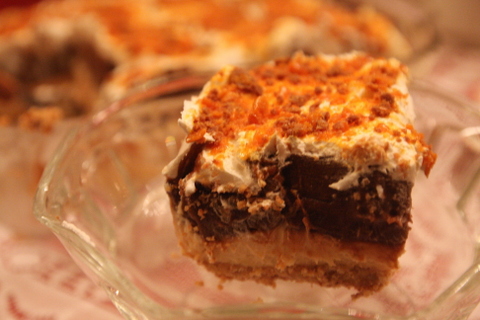
This luscious, rich dessert is a sweet symphony of creamy goodness.
Peanut Butter Dessert
This creamy, sweet Peanut Butter Dessert from Shakespeare Club member Pam Feld of Lake City offers an enticing ending for any meal.
For the crust:
1 cup finely-chopped cashews
1 cup all-purpose flour
1 / 2 cup butter
Cream cashews, flour and butter together. Press mixture into baking pan. Bake at 350 degrees for 25 to 28 minutes.
First layer of filling:
8 ounces cream cheese
1 / 3 cup creamy peanut butter
1 cup powdered sugar
1 cup whipped cream topping
Combine cream cheese, peanut butter, powdered sugar and whipped cream topping. Spread over cooled crust.
Second layer of filling:
2 2 / 3 cups milk
1 package chocolate instant pudding
1 package vanilla instant pudding
Combine milk and the two pudding mixes. Chill in refrigerator. When set, layer mixture on top of peanut butter layer.
Top dessert with whipped cream topping and pieces of chopped candy bars. Butterfinger and Heath work well.
Savor more Iowa food history
Want more great recipes and Iowa food stories? Check out my top-selling “Culinary History of Iowa” book from The History Press, and order your signed copy today.
P.S. Thanks for joining me. I’m glad you’re here.
@Copyright 2017 Darcy Maulsby & Co.
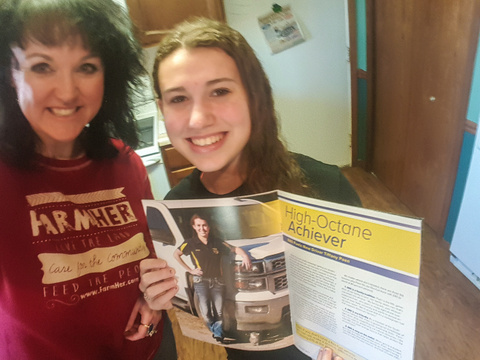
High-Octane Achiever: Ethanol Fuels New Driver Tiffany Poen
Most of us can vividly remember getting our driver’s license and our first car—our first taste of independence and grown-up responsibility. Fuzzier, however, is our first solo trip to fill up at the pump and the likely confusing choice we made purchasing gas. Not for Tiffany Poen, a new driver (and my awesome neighbor!) who is deliberate with her fuel choice.
Ethanol fuels her new adventure and, just like the truck she inherited from her grandfather, the choice was a matter of passing down a family tradition.
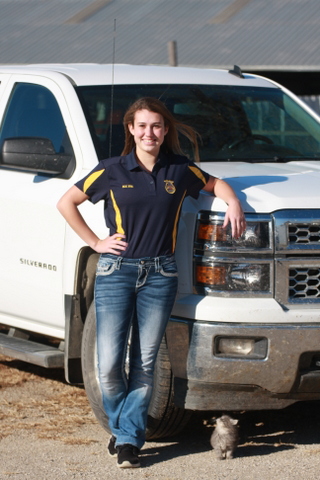
Tiffany Poen from Lake City, Iowa, is a proud South Central Calhoun FFA member and ethanol supporter.
“I really looked forward to getting my license and inheriting my grandpa Bob’s truck,” said Poen, 17, a high school junior from Lake City, Iowa. “This truck is special because my grandma Betty used to ride in it before she passed away in 2013 from complications of cancer.”
Family is important to Poen, who credits her grandfather, mom, and dad for teaching her to drive on the gravel roads near her family’s farm. After completing a driver’s education course, Poen was excited to receive her official driver’s license, which has opened up a new world of possibilities.
“I can go where I want,” said Poen, a high school basketball cheerleader and dancer who drives to practices at the local dance studio and joins friends at the community-owned movie theater where she volunteers.
No matter where she’s headed, there are three big reasons why Poen fills her flex-fuel truck with E85 (a blend of 85 percent ethanol):
1. E85 is a family tradition. Poen is the fifth generation of her family to farm. Her family raises corn that’s converted into ethanol. “My family only uses ethanol,” explained Poen, who plans to study agricultural business at Iowa State University and wants to pursue an ag sales career. “We’re proud that it’s a homegrown fuel that supports America’s farmers.”
2. E85 is eco-friendly. As a member of the South Central Calhoun FFA, Poen is growing her knowledge of agriculture while expanding her leadership skills. “Farming is focused on preserving our natural resources. I like how E85 is a clean energy source that helps protect the environment.”
3. E85 is easy on the wallet. When you’re a student, you have to make your money count. Poen appreciates how E85 and other ethanol blends are budget-friendly. “I want to make the best choices, and that includes E85.”
It was so much fun to interview Tiffany for this article, which appeared in the Winter 2017 issue of American Ethanol magazine, which is distributed nationwide. As you can see, even one of the Poen’s kittens got in on the act!
P.S. Thanks for joining me. I’m glad you’re here.
@Copyright 2017 Darcy Maulsby & Co.
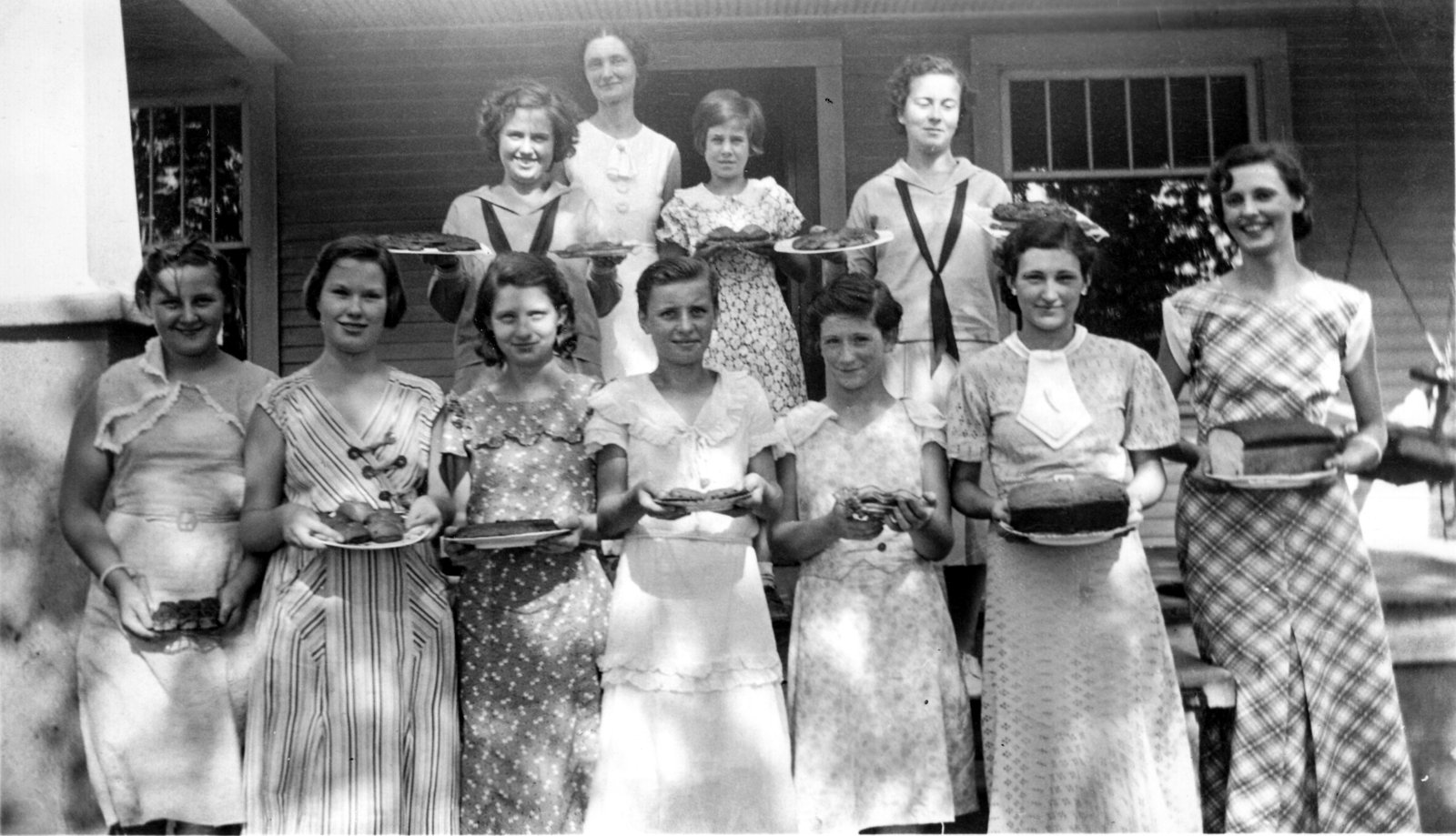
Growing with Grow: Iowa 4-H Leader Guides 100-Year-Old 4-H Club for 50 Years
With more than 50 years of experience leading the century-old Sugar Grove Sunshine 4-H Club in Dallas County, Iowa, Lorna Grow knows what it takes to help kids succeed. It doesn’t mean giving everyone a participation ribbon.
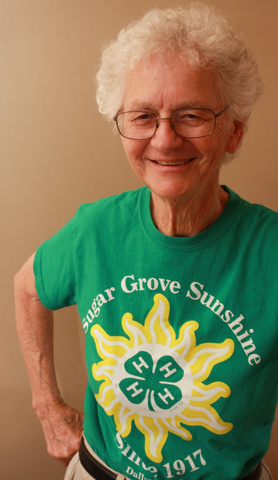
Lorna Grow has led the Sugar Grove Sunshine 4-H Club near Dallas Center, Iowa, since 1966.
“You gain confidence when you achieve,” said Grow, 84, a retired teacher who has guided Sugar Grove Sunshine 4-Hers since 1966 when her oldest daughter, Glenace, joined the club. “I expect high-quality work from my 4-H kids, and I coach them to help them learn.”
With her high-energy style, quick smile and lively personality, Grow is a hands-on instructor, whether she’s helping the kids refinish furniture, re-cane vintage chairs, bake a pie from scratch, sew on a button, hem pants, sew flannel-lined, zippered gun cases or complete basic home repairs like fixing a hole in the wall. While she coordinates 30- to 45-minute educational workshops that are held during the club’s meetings on the first Monday evening of the month, Grow doesn’t stop there.
“Because I’m retired, I can devote additional time for extra activities,” said Grow, a great-grandmother who marches in local parades with her 4-Hers, helps her club sponsor a county-wide cooking challenge for 4-Hers and their friends, inspires 4-Hers in design-a-room competitions, works with them throughout the Dallas County Fair and supports them at the Iowa State Fair.
Whenever there’s a local 4-H activity going on, Grow is there, said Aleta Cochran, county youth coordinator for Dallas County Extension. “The kids love Lorna. She always supports the kids, listens to them, encourages them and helps them grow.”
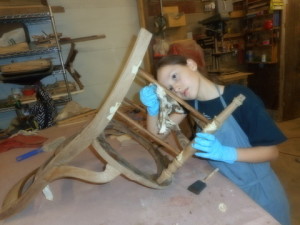
Refinishing furniture and chair caning offer Sugar Grove Sunshine 4-H Club members like Isabel Simpson the chance to learn skills they may not learn anywhere else.
A century of believing, a future of achieving
Grow has been involved with 4-H since 1943, when she joined the Union Lassies 4-H Club in Indianola. The all-girls club followed the traditional three-year program rotation of food, clothing and home improvement.
The club that Grow would become most affiliated with, however, is the Sugar Grove Sunshine 4-H Club in Dallas County. This group dates back to 1917, when a 4-H club led by Mrs. A.J. (Mary) Hayes was founded at Sugar Grove No. 9, a one-room country school near Dallas Center. This 4-H sewing club had 10 members, met weekly and wore blue uniforms with white caps. The entire club traveled to the Iowa State Fair by car (quite an outing in those days) and marched in the state fair parade behind the 168th Infantry.
The club evolved in 1922 into the Oblegro (Observe, Learn, Grow) Club. After an A.B.C. Club was organized in 1929, the two clubs joined and eventually became the Sugar Grove Sunshine 4-H Club, named after the local township. From 1918 through about 1965, the Dallas County Farm Bureau sponsored local 4-H clubs, which were separated into girls’ clubs and boys’ clubs.
“We are the oldest documented 4-H club in Dallas County,” said Grow, who added that 4-H clubs began to integrate in the 1990s. “I think the club’s founders would be surprised their group is still going all these years later when so many other 4-H clubs have died out.”
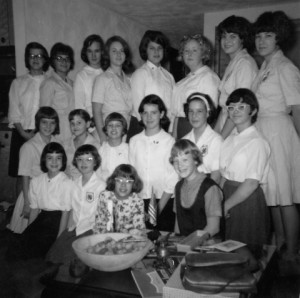
Sugar Grove Sunshine 4-H Club members, 1966-67
Today, the Sugar Grove Sunshine 4-H Club includes 42 boys and girls in grades 4 through 12 from Dallas Center, Adel, Van Meter, DeSoto, Perry, Grimes, Johnston and Urbandale. While it can be challenging for kids to find time for 4-H, due to busy schedules packed with sports, dance lessons and more, Grow refuses to schedule meetings on Sundays. “That’s family time,” she said.
Families are the key to success with any 4-H activity, she added. “I have wonderful 4-H kids because I have wonderful parents who care about their kids.”
Learning skills for life
These parents value the life lessons that 4-H teaches, including decision-making skills, goal setting, leadership and teamwork. To enhance the learning, Grow assigns older 4-Hers to help mentor younger club members.
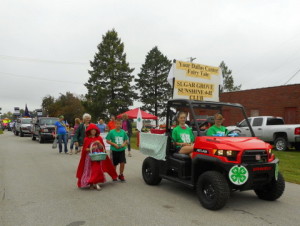
Members of the Sugar Grove Sunshine 4-H Club, along with club leader Lorna Grow, represented 4-H in this 2015 parade.
The Sugar Grove Sunshine 4-H members have also gained a new appreciation for history by helping plan the club’s 100-year-anniversary celebration, which was held Sept. 24, 2016, at the iconic Lake Robbins Ballroom near Woodward.
During the program, club members performed some of the songs that earlier generations of 4-Hers enjoyed from the 4-H Song Book. “The emphasis on music back then reflected people’s desire to get more culture into the rural areas,” said Grow, who added that the Adel Live Wires 4-H Club had an orchestra at one time.
Club members also researched local 4-H club record books dating back to the 1930s, when club projects included altering dress patterns and answering roll-call questions like “my favorite radio program.” Club members also scanned photos of previous generations of 4-Hers, including a group of girls showing off their baked goods for the 1934 Achievement Day. “Back then, you had to go through Achievement Day to have your project qualify for the Dallas County Fair,” Grow said.
While those early 4-H members used to meet in club members’ homes, today’s Sugar Grove Sunshine 4-H members meet in the basement of the Dallas Center Church of the Brethren. They also gather once a year at the Dallas Center-Grimes school to cook a meal and host an appreciation dinner for parents and guests. “We’ve served everything from Mexican to Chinese and prepare a four-course meal, including appetizers,” Grow said.
The learning opportunities that Grow offers 4-Hers are exceptional, emphasized Cochran with Dallas County Extension. “Lorna has done so much for 4-H. A volunteer like her is priceless.”
Grow said she’ll continue to serve as a club leader until she’s no longer effective. “Why do I keep doing this? Because I’m having fun. I love watching these kids grow and develop skills that will benefit them throughout their life.”
P.S. Thanks for joining me. I’m glad you’re here.
@Copyright 2017 Darcy Maulsby & Co.
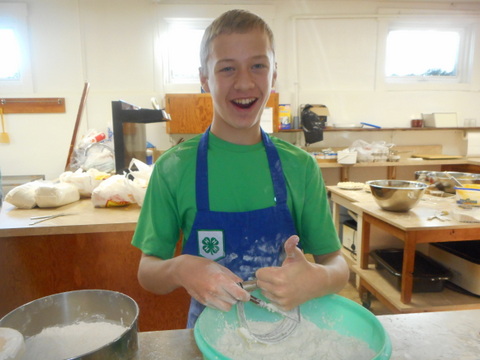
Members of the Sugar Grove Sunshine 4-H Club, like Jacob Storey, enjoy hands-on learning for pie baking and other skills.
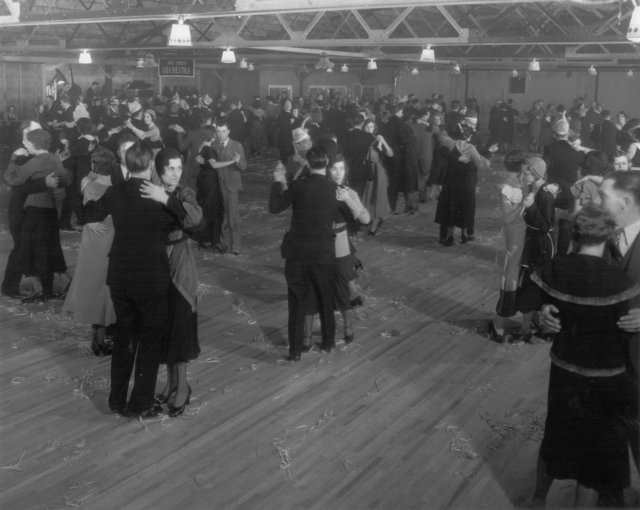
Celebrating New Year’s Eve in Style at a Classic Iowa Ballroom
There was a time when THE hottest place to be for New Year’s Eve was at one of Iowa’s ballrooms, which could be found across the state in cities, small towns and even in the country. While most of these iconic places are gone, Lake Robbins south of Woodward carries on a proud Dallas County tradition since 1931.
Here’s a glimpse of what makes Lake Robbins such a remarkable piece of Iowa history (photos courtesy Lake Robbins Ballroom):
Ringing in the New Year. The legendary Lake Robbins Ballroom opened Nov. 11, 1931, and soon became one of the hottest entertainment venues in Dallas County. With its 10,000-square-foot white oak dance floor (which is still in place), spacious interior and music from popular dance bands of the day, the ballroom became a destination. The photo at the top of this blog post which shows people dancing was likely taken on New Year’s Eve, circa 1933. Notice what appears to be confetti on the dance floor.
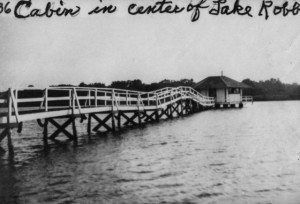
The beginnings of Lake Robbins. Located southwest of Woodward, Lake Robbins started as a natural pond. In the 1920s, Riley Robbins and his son, Mervin, built a man-made lake dredged out by teams of horses. Robbins built an eight-sided cabin with a boardwalk to the edge of the area that would become the famous Lake Robbins Ballroom. A drought in 1936 decimated the lake, which was not rebuilt.
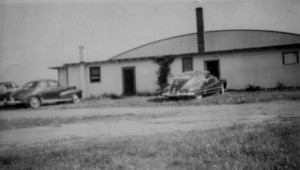
One of Iowa’s last ballrooms. Lake Robbins has always been in the country, and there’s only one way to get there—an unpaved country road. While the ballroom has always had a simple exterior, the magic occurs inside. Through the years, countless married couples first met at Lake Robbins. While many Iowa towns used to have ballrooms, Lake Robbins is one of the few that remains.
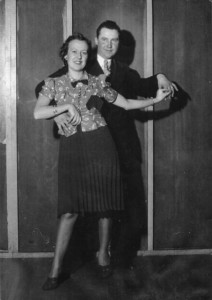
Soon-to-be-married dance champions. While they were not yet married when this photo was taken in 1938, Jacob Cushing of Adel and his future bride, Florence, won a dance contest at Lake Robbins Ballroom. The event was sponsored by Chaplin Gas & Oil. This photo was taken by Edmondson Studio in Perry.
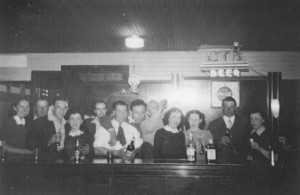
Celebrating the good times. Young people from Dallas County and beyond flocked to Lake Robbins Ballroom, which was one of the few places in the country that had electricity in the early 1930s. Some say future president Ronald “Dutch” Reagan patronized the ballroom when he was a broadcaster at WHO Radio in Des Moines. Lake Robbins was inducted into the Iowa Rock & Roll Music Association in 2007.
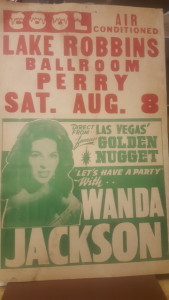 Let’s have a party! While some Lake Robbins performers slipped into obscurity, others became stars. Herbie Kay’s orchestra from Chicago that played opening night in 1931 featured 17-year-old vocalist Dorothy Lamour. In 1936, Lamour moved to Hollywood and made a series of successful comedies starring Bing Crosby and Bob Hope. Another Lake Robbins singer, Perry Como, had huge hits in the 1950s with “Magic Moments” and “Catch a Falling Star.”
Let’s have a party! While some Lake Robbins performers slipped into obscurity, others became stars. Herbie Kay’s orchestra from Chicago that played opening night in 1931 featured 17-year-old vocalist Dorothy Lamour. In 1936, Lamour moved to Hollywood and made a series of successful comedies starring Bing Crosby and Bob Hope. Another Lake Robbins singer, Perry Como, had huge hits in the 1950s with “Magic Moments” and “Catch a Falling Star.”
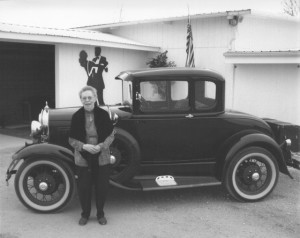
Kip Shannon’s 80+-year career. While she didn’t work on the opening night (Nov. 11, 1931), 23-year-old Coloma “Kip” Shannon stopped by the new Lake Robbins Balloom with her family. She got a job selling tickets there soon after and also handled practically every job at the ballroom during her career, which spanned nearly 80 years at Lake Robbins. Kip died at age 105 in 2014.
Today, owner Lyn Wilkinson carries on the Lake Robbins Ballroom Iowa legacy, caring for the beloved ballroom that she has owned since 1993. Stop by this remarkable venue for an evening of music, dancing and an unforgettable piece of Iowa history.
Want more Iowa culture and history? Lake Robbins Ballroom will be featured in my upcoming book, Dallas County, a pictorial history from Arcadia Publishing, which will be released in the summer of 2017. In the meantime, check out my top-selling “Calhoun County” book, which showcases the history of small-town and rural Iowa, as well as my “Culinary History of Iowa” book from The History Press. Order your signed copy today!
P.S. Thanks for joining me. I’m glad you’re here.
@Copyright 2017 Darcy Maulsby & Co.
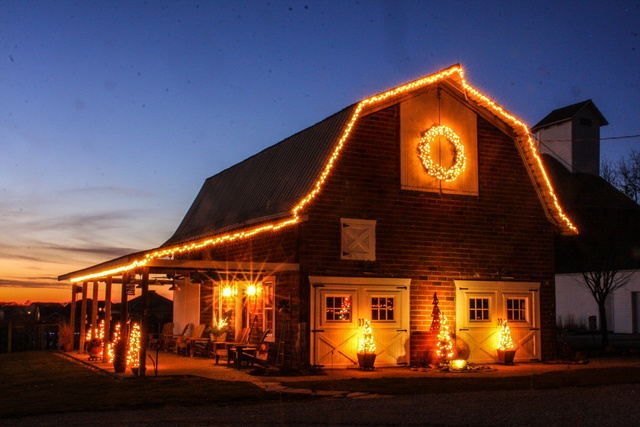
Adel Barn Accents Penoach Winery in Iowa
It started as a dairy barn in the 1920s on a farm north of Adel. By the mid-1990s, the farm was gone but the barn remained part of an acreage surrounded by new housing developments. In 2006, the barn became the hub of Penoach Winery and remains a big draw at this central Iowa destination.
“I like the fact that the barn is rustic and has lasted all these years,” said Joanie Olson, who runs Penoach Winery with her husband, Stan. “Our customers also love the old barn.”
The clay-tile barn was built on the H.B. Kinnick farm north of Adel to house dairy cattle. It was likely constructed with clay-tile blocks made in Adel. Olson recently met an 89-year-old gentleman from Arizona who is related to the Kinnick family and grew up on the farm.
“His father lost the farm during the Great Depression of the 1930s,” Olson said. “This man recalled sitting on the back porch and crying during the farm auction.”
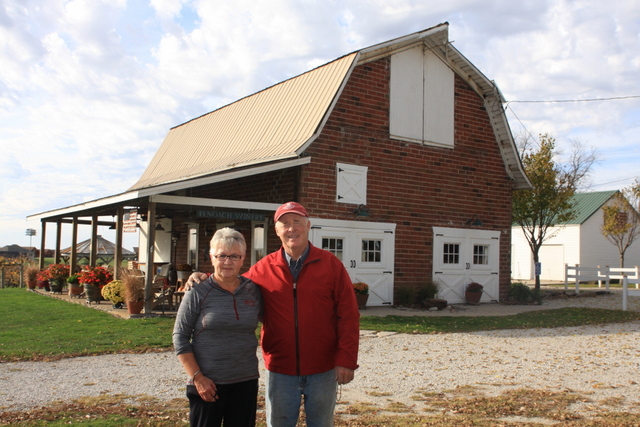
Stan Olson and his wife, Joanie, run Penoach Winery in this historic barn at their acreage north of Adel, Iowa.
In 1960, Olson’s parents, Paul and Mildred Hufferd, purchased the 240-acre farm, where they raised crops, cattle and hogs. Olson moved back to her family’s farm around 1980-81 with her husband, Stan, who had grown up on a farm near Lake Mills. The couple farmed for about 15 years. “My dad raised pigs in the barn, and then Stan did, too,” Olson said.
Although Stan began selling insurance after he quit farming, he never lost his passion for agriculture. “Stan missed growing things, so he planted 50 grape plants in 1999,” Olson said. In 2000, the Olsons started a grape nursery to supply grape vines to wineries that were taking root across Iowa.
Within a few years, the Olsons decided to start their own vineyard and winery. Penoach Winery, which reflects Adel’s original name, opened in 2006. Today, the operation includes 4 acres of grapes behind the barn, not far from areas once covered by cornfields and a hog lot.
“The barn was in pretty good shape when we started remodeling it for the winery,” Olson said. “We worked from top to bottom, starting with cleaning out the hay and pressure washing the barn.”
The transformation also included new floors, electrical wiring, plumbing, windows, doors and a covered patio on the south side of the barn. “Stan did most of the work,” Olson added.
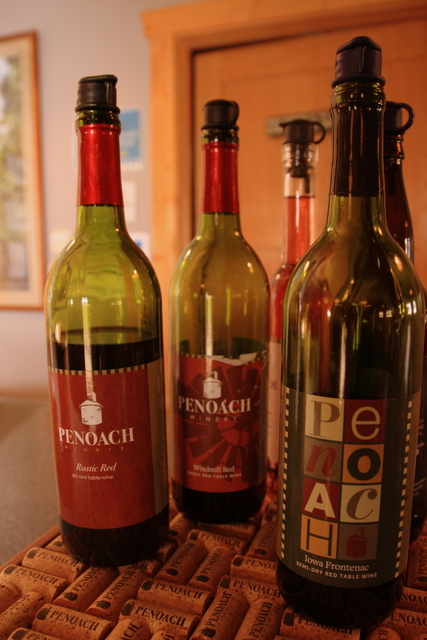
Penoach Winery offers a variety of Iowa wines produced from grapes grown on the Olson’s acreage north of Adel, Iowa.
While couple installed their wine-making equipment in the back of the barn, the space wasn’t quite large enough. About four years ago, the couple moved this equipment to a nearby shed and transformed the back room of the barn into a gathering space, complete with comfortable chairs. In the adjoining room, guests can browse the gift shop, which showcases 18 varieties of wine made at Penoach Winery.
“We enjoy meeting lots of people who visit our winery,” Olson said. “We’re glad we can share our barn with them.”
Want more Iowa culture and history? The barn at Penoach Winery will be featured in my upcoming book, Dallas County, a pictorial history from Arcadia Publishing, which will be released in the summer of 2017. In the meantime, check out my top-selling “Calhoun County” book, which showcases the history of small-town and rural Iowa, as well as my “Culinary History of Iowa” book from The History Press. Order your signed copy today!
P.S. Thanks for joining me. I’m glad you’re here.
@Copyright 2017 Darcy Maulsby & Co.
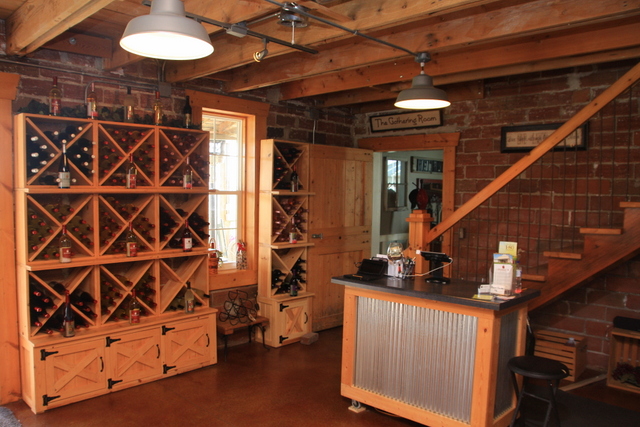
The interior of this former dairy barn is now an inviting, relaxing place to sample Iowa wines.
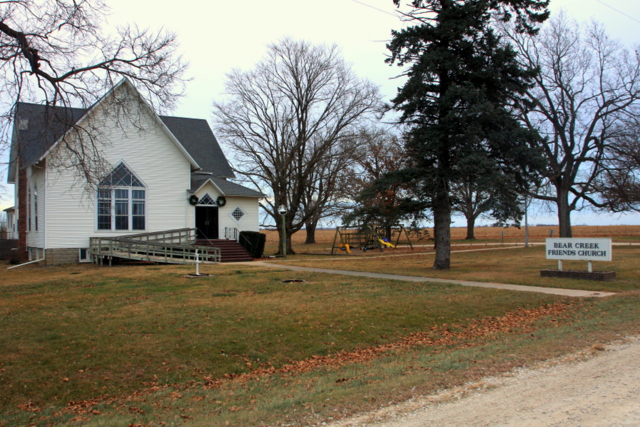
Slaves Escaped Through Dallas County on Iowa’s Underground Railroad
Imagine you’re a fugitive slave on the run in 1850s Iowa. You’ve managed to escape from Missouri and have made it all the way to Dallas County, but your owner and bounty hunters are close behind. If youor the people who are helping you escape on the Underground Railroad—get caught, the consequences are terrifying.
This really happened near the Quaker Divide northeast of Dexter, Iowa, around 160 years ago. It occurred after the federal Fugitive Slave Act of 1850 made it easier for southern slave owners to recovery their property and levied harsher punishments for anyone interfering in the capture of runaway slaves.
I’m going to include the story in my upcoming “Dallas County” book from Arcadia Publishing, which will be released in the summer of 2017. This will be my third book that helps bring Iowa history to life, along with Calhoun County and A Culinary History of Iowa.
Here’s a first-person look into the Underground Railroad in Iowa, as told by those who lived it. This excerpt comes from the “History of the Quaker Divide” by Darius B. Cook, published by the Dexter Sentinel, Dexter, Iowa, 1914. The story of the Underground Railroad documented here was written by Harmon Cook, who shared his personal experiences as one of its conductors:
Running away to freedom
In the days before the Civil War, Dallas County was on the frontier. Slavery was recognized as a product of Missouri. Iowa being a free state naturally proved a highway for the Underground Railroad. John Brown came through the area. The route started from Tabor in Fremont County and crossed diagonally Adair County, striking Summit Grove, where Stuart is now located.
“From there, one line went east down Quaker Divide, and the other crossed the Raccoon River near Redfield, then through Adel. Both lines came together at Des Moines, on to Grinnell to Muscatine and up to Canada. Many times I have seen colored men and women crossing the prairie…slaves running away to freedom.
In the winter of 1859-60, I was going to school to Darius Bowles, and one Friday evening I was told if I wanted to go to Bear Creek, I would not have to walk, if I wanted to drive a carriage and return it Monday morning. I drove the carriage, and in it were two young colored women. They were sisters and from the west border of Missouri. Their master was their father, and they had both been reared in the family.
War was apparent, and their master decided to sell them “down south.” They heard the plotting, and found out that they were to go on the auction block, and made a run for the North Star. They had been on the road seven weeks when they arrived at A.W.L’s at Summit Grove. Before daylight Saturday morning, they were housed at Uncle Martin’s.
You won’t find any slaves here
One Monday afternoon, one of the sisters, Maggie, who had been out in the yard came running in and told grandmother, “Master is coming up the road!” Grandfather went out in the front and sat down in his chair against the side of the door.
By this time, a number of men had ridden up and asked him if he had seen any slaves around. He told them slaves were not known in Iowa.
Then one of them said, “I am told that you are an old Quaker and have been suspected of harboring black folks as they run away to Canada. I have traced two girls across the country, and have reasons to believe they have been here.”
Grandfather said, “I never turn anyone away who wants lodging, but I keep no slaves.”
“Then I’ll come in and see,” said the man, who jumped off his horse and started for the house. Grandfather stood up with his cane in his hand and stepped into the door when the man attempted to enter. Grandfather said, “Has thee a warrant to search my house?”
“No, I have not,” replied the man.
“Then thee cannot do so,” Grandfather said.
“But I will show you,” said the man. “I will search for my girls.”
While this parley was going on, and loud words were coming thick and fast, Grandmother came up and said, “Father, if the man wants to look through the house, let him do so. Thee ought to know he won’t find any slaves here.”
Grandfather turned and started at her a minute, then turning to the men, said, “I ask thy forgiveness for speaking so harshly. Thee can go through the house, if Mother says so.”
Grandfather showed him through all the rooms but stayed close to him all the time. After satisfying himself that they were not there, he begged the old man’s forgiveness, mounted his horse and rode away.
When the coast was clear, it was found that when Maggie and rushed in and said, “Master is coming,” Grandmother hastily snatched off the large feather bed, telling both the girls to get in and lie perfectly still. She took the feather bed, spread it all over them, put on the covers and pillows, patted out the wrinkles—and so—no slaves were seen.
Almost caught
One time a big load was being taken down the south side of the Coon River and had reached the timber on the bluffs near Des Moines. About 3 o’clock in the morning as the carriage was leisurely going along, the sound of distant hoofbeats were heard coming behind. At first it was thought the carriage could outrun its pursuers, but prudence forbade.
A narrow road at one side was hastily followed a few rods, and the carriage stopped. The horseman passed on, swearing eternal vengeance on the whole “caboodle,” if captured. When sounds were lost in the distance, a dash was made for the depot in Des Moines, and all safely landed before daylight.
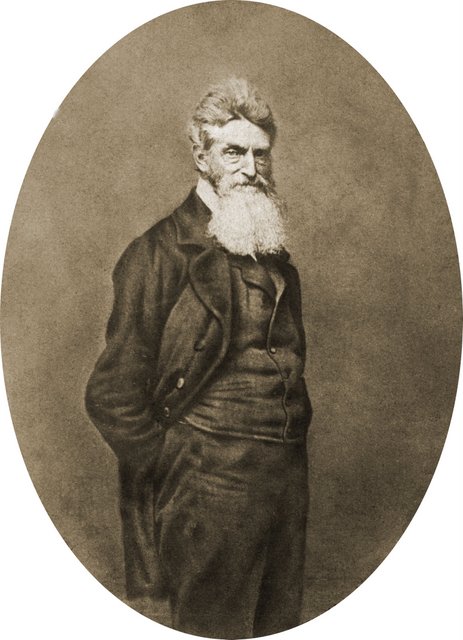
John Brown, abolitionist, aided the Underground Railroad in Dallas County, Iowa
John Brown came to Dallas County
One evening some months after I was returning from Adel on horseback and when opposite Mr. Murry’s farm east of Redfield when I saw Old Man Murry and a stranger back of the barn. I was met by an old man, rather stoop-shouldered and of stern aspect. “Mr. Murry said, “Here’s the youngster who came so near getting caught going to Des Moines.” The stern man with shaggy eyebrows almost in my face said, “Young man, when you are out on the Lord’s business, you must be more discreet. You must always listen backwards, as you are always followed. I’m responsible for that track of the Underground Railroad, and I want my conductors to be more careful in the future, as things are coming to a head, and somebody is going to get hurt.”
I was dismissed with this admonition: “Young man, never do so rash a thing again as to talk and laugh out loud on the way.” A few months later, when Harper’s Ferry was known to fame, I remembered John Brown as the old man at Murry’s.
Editor’s note: In 1859, John Brown led a small group of men who plotted to overthrow the institution of slavery by violent means, starting with a raid on the U.S. arsenal at Harper’s Ferry, West Virginia. Brown intended to incite a slave insurrection. Although he was suppressed by federal forces, Brown became a martyr in the eyes of the Abolitionist movement. Brown’s unsuccessful raid, along with the election of Abraham Lincoln in 1860, led Southern states to believe that they could never survive under an anti-slavery president. South Carolina led the Southern states in secession from the Union in December 1860, followed by Alabama, Mississippi, Georgia, Florida, Louisiana and Texas.
Reconnecting with a fugitive slave
Harmon Cook continued with his memories of the Underground Railroad in Dallas County:
When I enlisted in Company C, 46th Iowa Infantry, and arrived at Memphis, Tennessee, in 1864, I first saw a regiment of colored soldiers. They were in camp and the first opportunity I was over to see how they looked as soldiers. One of the camp scenes was some of the soldiers conducting a school to teach these poor people their ABCs.
Chaplain Ham and I had gone together, and the teacher, who was the lieutenant colonel, asked us to speak to the colored school. When I had spoken, a strapping fellow in blue uniform came rushing up to me, shouting, “I know you! You belong to the Quaker Divide in Iowa. You drove me one night when we were trying to get into town and were followed by our masters, and you drove off into the woods and we got out and hid.”
It was Henry who had been one of the party in that wild midnight ride. He never got to Canada, but stopped in Wisconsin, and when the war came on he enlisted. He was lieutenant of the colored regiment and was a trusted scout for the general of our division.”
Background notes on the Underground Railroad in Dallas County
The Bear Creek Settlement, also known as the “Quaker divide” in southern Dallas County north of Dexter, is located between the South Raccoon River on the north and Bear Creek on the south.
In the early 1850s this area was open prairie without a single settler. But a Quaker family (including Richard Mendenhall and his wife, Elizabeth) from Marion County, Indiana, settled in Dallas County in 1853 in Union Township in what would become the Quaker Divide.
While the Quakers were among the most prominent slave traders during the early days of America, paradoxically, they were also among the first religious denominations to protest slavery. While not all Quakers participated in the organized anti-slavery movement, many did—including many in Iowa.
Traces of the Underground Railroad remain in Iowa—see for yourself
There are remarkable places across Iowa where you can see the few remaining stops on the Underground Railroad that are still standing and open to the public. I’ve toured many of these remarkable sites, and they are well worth a road trip. Click here to get more details on the Hitchcock House in Lewis, the Jordan House in West Des Moines and the Lewelling House in Salem and more. I encourage you to visit these Underground Railroad sites and reconnect with this powerful chapter of Iowa history.
Want more Iowa culture and history? Check out my top-selling “Calhoun County” book, which showcases the history of small-town and rural Iowa, as well as my “Culinary History of Iowa” book from The History Press. Order your signed copy today!
P.S. Thanks for joining me. I’m glad you’re here.
@Copyright 2017 Darcy Maulsby & Co.
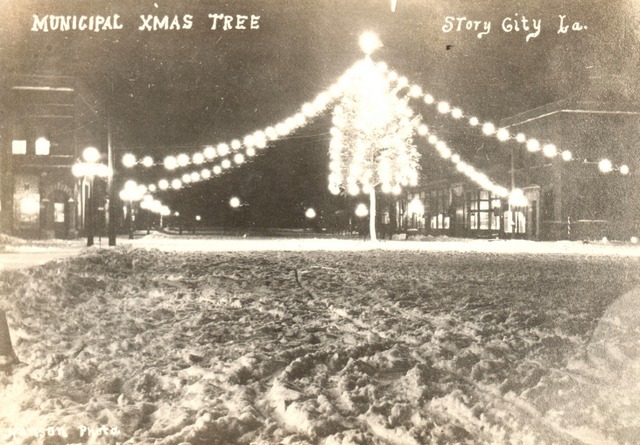
O, Christmas Tree! Small Iowa Towns Celebrate with Trees in the Middle of the Street
For a select group of small Iowa towns, it just wouldn’t be Christmas without a lighted tree downtown—right in the middle in the street. In Story City, the community has celebrated this beloved holiday custom for more than 100 years.
“I’m not surprised this tradition has lasted all these years,” said Kate Feil, director of the Story City Historical Society. “Keeping traditions alive are a big part of Story City, from the annual Scandinavian Days Festival to the municipal Christmas tree.”
This year’s evergreen tree was donated by Ole and Jackie Skaar of Story City and was installed by the Municipal Electric Company at the corner of Broad Street and Pennsylvania Avenue. Hundreds of people attended the Yulefest tree lighting ceremony on the evening of Nov. 25. Excitement intensified during countdown from 10 to 1 before the lights were flipped on. Then the high school choir led the singing of Christmas carols, and guests could warm up with cups of hot chocolate. The Story City Fire Department hosted their annual chili supper following the tree lighting ceremony.
“Families plan their Thanksgiving gatherings each year so they can attend the tree lighting ceremony,” said Abby Huff, executive director at Story City Greater Chamber Connection. “It’s a tradition we hope to carry on for many more years to come.”
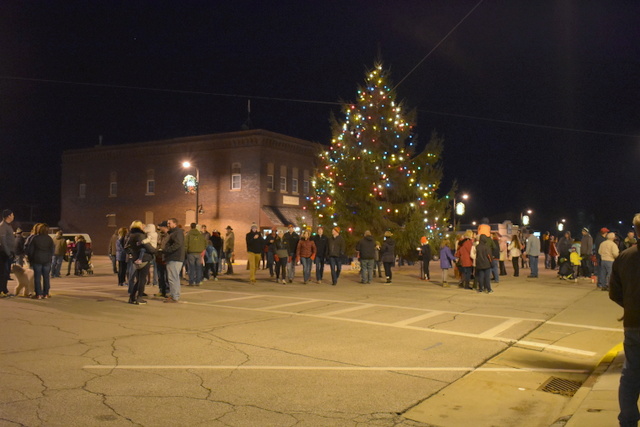
Hundreds of people attended the Yulefest tree lighting ceremony in Story City, Iowa, on the evening of Nov. 25. Excitement intensified during countdown from 10 to 1 before the lights were flipped on. Then the high school choir led the singing of Christmas carols, and guests could warm up with cups of hot chocolate.
Let there be light
In 1914, Story City became one of the first towns in Iowa to display a municipal Christmas tree with electric lights. While many Iowa communities had begun to offer electrical service in the late 1890s and early 1900s, electricity was still a novelty that held the power to fascinate, especially in rural areas.
At that time, electricity was out of reach for thousands of farm families, many of whom wouldn’t receive electrical service until the federal Rural Electrification Act of 1936 brought power to rural America in the late 1930s and into the 1940s.
When Story City harvested its first municipal Christmas tree in town in 1914, local citizens decorated the tree with large, multi-colored lights. The lighting of the tree became a memorable event for a town that had not fully integrated electricity into all homes. A man who was visiting Story City during the Christmas season in 1914 described the tree as “the biggest stunt the town ever pulled off.”
Other communities took note. After Story City celebrated its first lighted Christmas tree, the event attracted newspaper coverage across the Midwest, and the concept of municipal Christmas trees started gaining popularity in small towns across Iowa and beyond.
Story City’s municipal Christmas tree has even reflected noteworthy moments in American history. No municipal Christmas trees were displayed in Story during World War 2 from 1942 to 1944, Feil said. Also, there was no tree in 1973, and no street ornaments were lit that year, due to the nation’s energy crisis.
Nothing caused more consternation, however, than a decision in 1948 to place a decorative Santa and sleigh with four horses from the town’s iconic carousel at intersection of Broad Street and Pennsylvania Avenue instead of a tree. It didn’t go over well, Feil said. “People like the tree.”
Today, many community members, including Mayor Mike Jensen, have helped make sure Story City has a municipal Christmas tree each year. Since it can be a little difficult to find trees that are right for the municipal tree, community leaders have begun planting evergreens near the soccer fields in the northwest part of Story City, said Huff, who noted that Story City is a member of Trees Forever. These trees will help ensure this beloved tradition lives on.
“From the first tree in 1914 to our current tree, I love the feeling of community our municipal Christmas tree continues to bring each year,” Feil said.
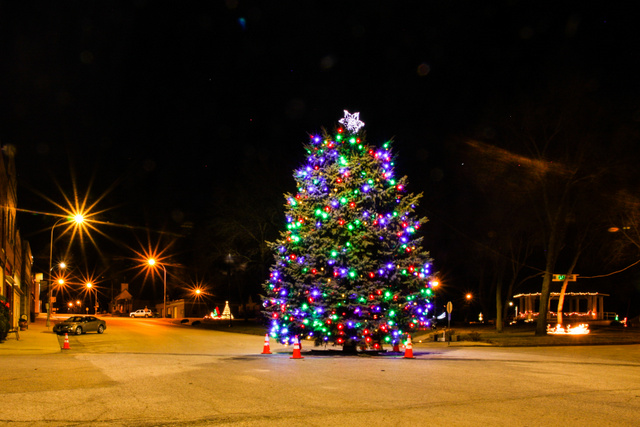
The municipal Christmas tree is unique feature of Exira, Iowa, population 840, which is also known for its 4th of July celebration. “It’s a proud tradition we want to keep around for years to come,” says the city clerk.
Christmas tree helps define Exira
On the other side of the state in Exira, population 840, local residents also cherish the tradition of a municipal Christmas tree that stands tall in an intersection downtown near the town square.
“We’ve had a tree each Christmas for many years,” said Lexi Christensen, Exira’s city clerk. “A lot of people compliment us on this tradition.”
This year’s tree, which was donated by Lana Wiges of Hamlin, was set up the Saturday after Thanksgiving. The tree was officially lit when Santa Claus came to town during the first weekend in December. Has anyone ever crashed into the holiday icon? “Fortunately not,” Christensen said.
As part of the tree lighting celebration, guests enjoyed soup and homemade treats at the local recreation center, while the Exira Community Club collected food and toys to donate to local families in need. “The Christmas tree is unique feature of Exira,” said Christensen, who added that Exira is also known for its 4th of July celebration. “It’s a proud tradition we want to keep around for years to come.”
Remsen revives Christmas tree tradition
Municipal Christmas trees used to be a much more common sight in small Iowa towns, but the tradition faded away in many communities due to the work involved, declining populations and other factors. To Tammy Maaff-Portz, it was a tradition worth reviving in her hometown of Remsen, population 1,663.
“I’d say the tradition had died out by the mid-1960s, but a group of us wanted to bring back an old-fashioned Christmas with a tree in the middle of the road. We made it happen in 2003 and have been carrying on this tradition ever since.”
This year’s municipal Christmas tree stands about 30 feet tall on Main Street and is covered with an array of oversized green and red ornaments and approximately 3,000 lights, including a lighted star on top. The massive tree sits in a permanent hole dug into the street downtown and is held in place with a support system designed for this purpose. The hole in the street is covered with a steel plate the rest of the year.
The lighting of the municipal Christmas tree, which took place the first Monday evening in December, started with a blessing of the tree by local religious leaders. Then Santa arrived on a vintage fire truck and lit the tree before heading to the Remsen Heritage Museum, where children could share their wish list with him and receive a candy cane.
Remsen’s businesses stayed open that evening until about 8 p.m. Carolers walked from shop to shop, singing songs of the season, while visitors enjoyed horse-drawn wagon rides as sleigh bells rang throughout Main Street. Children took advantage of Kids’ Korner, where they could shop for gifts for their family and either wrap the presents themselves or get a little help from the business owners.
“Living windows” in local stores have also become a popular part of the celebration. This year, members of the St. Mary’s boys’ basketball team were at Schorg’s Custom Cabinetry, where visitors could visit with them while decorating their own Christmas cookies.
“All these events are free and open to the public,” said Maaff-Portz, who owns Furnishings on Second At Muller’s. “People of all ages love it.”
Remsen’s municipal Christmas tree stays lit all through the night, every night, until the tree is taken down during the first few weeks of January. Maaff-Portz is already looking forward to a gala event in a few years to celebrate the 15th anniversary of the municipal Christmas tree’s triumphant return to Remsen. “It’s definitely a community effort. We want to make this a family and community tradition as long as we can.”
Christmas Trees Thrive in Iowa
The modern Christmas tree is believed to have originated in Germany in the 16th century. Here are some other Christmas tree facts from the Iowa Department of Agriculture and Land Stewardship:
- Iowa has more than 100 Christmas tree farms in all parts of the state.
- These farms devote more than 1,500 acres to Christmas tree production in Iowa and harvest approximately 39,500 Christmas trees each year.
- It takes 6 to 12 years to grow a Christmas tree before it is ready to be sold.
- Christmas tree farms in Iowa are part of a $1 million industry that contribute to the state’s economy.
*This article first appeared in Farm News, December 2016
Want more Iowa culture and history? Check out my top-selling “Calhoun County” book, which showcases the history of small-town and rural Iowa, as well as my “Culinary History of Iowa” book from The History Press. Order your signed copy today!
P.S. Thanks for joining me. I’m glad you’re here.
@Copyright 2016 Darcy Maulsby & Co.

Is This Iowa’s Favorite Appetizer?
Who would have thought pickle wraps (a.k.a. pickle roll-ups) would be the hot food topic this holiday season? Of course, you don’t need a holiday to celebrate if you want to enjoy some “Iowa sushi,” as I explained to Des Moines Register reporter Courtney Crowder recently.
Here’s the great article from Courtney, along with my take on why pickle wraps are so undeniably Iowan (along with recipes, of course!)
Is This Iowa’s Favorite Appetizer?
Courtney Crowder , ccrowder@dmreg.com8:28 a.m. CST December 15, 2016
http://www.desmoinesregister.com/story/entertainment/dining/2016/12/14/iowas-favorite-appetizer/94676550/
My obsession with “Holiday Pickle Wraps” — also known as “Iowa Sushi” or “Lutheran Sushi” — began with a Facebook post.
Just before Thanksgiving, fellow reporter John Naughton posted a picture of a Hy-Vee display replete with cream cheese, pickles, dried beef and a sign noting that it was time for “Holiday Pickle Wraps.” Above the photo he wrote, “Sure sign you’re in Iowa.”
To me, the sign and its gathered foodstuffs might as well have been in a foreign language. Pickle wraps? Naughton’s post should have read: “A sure sign you’re not from Iowa.”
After living in the Hawkeye State for two years, I like to think I have at least a passing grasp on what is Iowan, but here I was simply gobsmacked by pickle wraps. What exactly are pickle wraps? Are these truly Iowan or just a quick appetizer Iowans are co-opting? And, most importantly, aren’t they incredibly salty?
“No, they’re not overly salty,” I was assured by Darcy Maulsby, lifelong Iowan and author of “A Culinary History of Iowa: Sweet Corn, Pork Tenderloins, Maid-Rites & More.”
“Pickle wraps are very, very popular in Iowa,” Maulsby added. “So many friends say pickle wraps are the first thing on the appetizer tray to go at their parties.”
Traditionally, a pickle wrap begins with a pickle (obviously), which is then slathered in cream cheese, wrapped in ham and cut into bite-sized pieces. However, there are variations on the general pickle wrap theme, Maulsby said. Some people sheathe the ham with a tortilla and others don’t use ham at all, instead opting for a dried beef encasement. Others make pickle wrap dip, where all the indigents of a pickle wrap are blended together and served with crackers.
“This is definitely a Midwestern thing,” Maulsby said. “You go to Arizona, Oklahoma, California, Michigan, they’ve never heard of a pickle wrap. Some Wisconsin and Minnesota people do know about pickle wraps, but I think Iowans should embrace this as our own, for sure.”
The exact genesis of the pickle wrap — or pickle roll-up as it is also called — is unknown, but Maulsby said the appetizer most likely originated as a modification of an old-world German recipe.
“I think of this as being in the same category as the fried breaded pork tenderloin, as far as its German-ness goes,” she said. “Anytime you have a German community or a place with a strong German heritage, you got pickles and red meat and that is two-thirds of a pickle wrap right there.”
As with its origins, the enduring legacy of the pickle wrap is up for grabs as well. So what is it that keeps Iowans coming back to the simplest of hors d’oeuvres?
“It’s the pickle wrap’s flavor sensation, and it’s a texture thing, too,” Maulsby said. “It does everything a good food should do: It’s interesting to the palate. The tang of the pickle plays nicely off of the smooth cream cheese and salty meat. The crunch of the pickle is in contrast to the creaminess of the cream cheese. As a food, it does so many things well.”
The best thing about the pickle wrap is that it is soeasy to make that even I, a cooking novice, feel confident in my abilities to master the roll-up. Simply slather, wrap and cut. But Maulsby urges chefs not to rest on their pickle wrap laurels, but to attempt their own variation on the classic roll-up. Take something conventional and make it your own!
“There are a lot of fun things you could do with pickle wraps,” Maulsby said, “and no one is going to get too worked up if you tweak the classic roll-up — at least I don’t think they will.”
Pickle wrap recipes
Here are culinary historian Darcy Maulsby’s favorite pickle wrap and pickle wrap dip recipes. To learn more about her work and other classically Iowan foodstuffs, check out her website at Darcymaulsby.com.
Classic Iowa pickle wraps
1 jar dill pickles
Ham slices
Cream cheese, softened
Lay the ham slices flat on a serving plate and pat dry. Spread with cream cheese. Place a pickle spear at one end of each slice and roll the slices into cylinders around the spears. Secure with toothpicks. Chill in refrigerator. Cut into bite-sized pieces.
Tortilla pickle-ham rolls
1 (32 ounce) jar dill pickles
1 (8 ounce) package cream cheese, softened and divided (make certain that the cream cheese is very soft for spreading)
1 pinch garlic powder, to taste (optional)
1 pound sliced cooked ham (I like to use honey ham)
6-inch flour tortillas
Mix the softened cream cheese with garlic powder (if using). Spread a thin layer of the cream cheese onto one side of a tortilla. Place 1 slice of ham over the cream cheese. Spread another layer of cream cheese over the ham. Roll a pickle up in the tortilla. Cover the roll with plastic wrap and chill for 2 hours (to make slicing easier). Remove the plastic wrap. Using a serrated knife, slice the roll into about 1-inch pieces or to desired size.

Dried beef pickle dip
1 package (3 ounces) dried beef, finely chopped
1 package (8 ounces) regular or reduced fat cream cheese
1/2 cup reduced fat sour cream
2 tablespoons chopped green onion
1/2 to 1 cup coarsely chopped dill pickles (not dill relish)
1/4 teaspoon pepper
Soften cream cheese and combine with remaining ingredients. Chill until serving. Serve with crackers or fresh vegetables.
— Dip recipe from the Iowa Beef Industry Council.
Savor more Iowa food history
Want more great recipes and Iowa food stories? Check out my top-selling “Culinary History of Iowa” book from The History Press, and order your signed copy today.
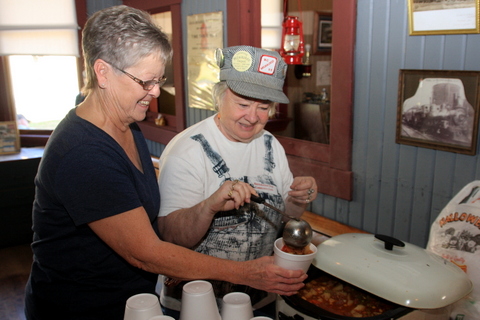
All Aboard! Rockwell City’s “Depot People” Offer a Taste of Iowa History
Eating like a hobo never tasted so good, at least when the “Depot People” are cooking. The savory aromas that emanate from the historic railroad depot in Rockwell City for one afternoon each fall signal that something good is coming down the line.
“I love this little museum and enjoy giving people a taste of the past,” said Carol Hupton of Rockwell City, president of the board of “Depot People” who have transformed the 1899 depot and freight shed into a museum.
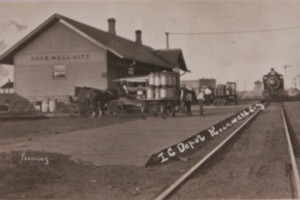
A train rolls into the Illinois Central Railroad depot in Rockwell City years ago.
During the annual fundraiser, which Hupton has helped with for the past six years, home cooking offers a feast at the Rockwell City depot a block north of the Calhoun County courthouse. Guests can dine on homemade hobo stew, hot dogs, homemade cookies, bars and more, with all proceeds going to restoration projects at the depot.
Saving the depot has been a labor of love for the Depot People, a group of about 25 people who want to preserve their community’s history. “There was a time when the depot was in danger of being torn down,” said Hupton, who has been volunteering with the depot museum for 10 years. “People don’t always realize the important role the railroad played to help Iowa and small towns like Rockwell City grow.”
The first railroad to arrive in Rockwell City was the Des Moines & Northern line, which was later taken over by the Chicago, Milwaukee & St. Paul Railway. The first passenger train rolled into town in 1881.
Rockwell City’s second railroad was the Illinois Central. Surveying the land between Fort Dodge and Rockwell City for this rail line began in 1899. Around 1903, the Newton and Northwestern Line, an interurban line, became the third rail line to Rockwell City. For decades, it brought passenger cars from Newton and Des Moines every two hours from 7 a.m. to 9 p.m.
During the heyday of the railroad, Rockwell City became a stop for multiple passenger trains and freight trains each day. Weary travelers could enjoy a meal at the nearby Hotel Brower or various restaurants in town.
In time, paved roads and interstate highways led to increased traffic from cars, pickup trucks and semi-trucks across Iowa and the nation, marking the end of an era for passenger trains. Railroad transportation itself changed as powerful diesel engines replaced the steam engines that once powered the many trains that rolled across the Iowa countryside. “Now the old depot here in town stands alone as a reminder of our history with the railroads,” Hupton said.
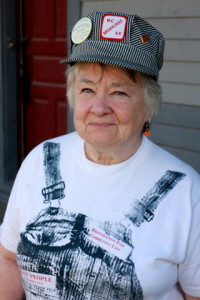 Sharing this history is important to Hupton and her fellow volunteers. The depot’s fundraising meal offers another way to encourage people of all ages to visit the museum. “Many kids don’t know anything about the history of the railroad in Rockwell City or other small Iowa towns,” Hupton said.
Sharing this history is important to Hupton and her fellow volunteers. The depot’s fundraising meal offers another way to encourage people of all ages to visit the museum. “Many kids don’t know anything about the history of the railroad in Rockwell City or other small Iowa towns,” Hupton said.
That’s why the Depot People have created historical exhibits in the depot, including vintage photos of the depot, to show the important role it once played in the community. A recreated hobo camp east of the freight shed also helps visitors learn how the railroad influenced people’s daily life in various ways.
The Depot People continue to apply for grants and host fundraisers with meals to preserve local railroad history. A summer car show allows car, truck and motorcycle fans to display their prized vehicles, while guests can dine on pulled pork sandwiches, potato chips, homemade desserts.
In the fall, the depot becomes an informal dining room where guests can enjoy a hearty bowl of homemade hobo stew, sugar cookies, salted nut roll bars and other goodies prepared by some of Rockwell City’s best cooks and depot supporters, including Maurine Zuetlau.
“Rockwell City’s depot is a landmark,” Hupton said. “We’ll continue to do what we can to preserve this local history.”
Savor more Iowa food history
Want more fun Iowa food stories and recipes? Check out my top-selling “Culinary History of Iowa” book from The History Press, and order your signed copy today.

Hearty Hobo Stew from Iowa
Hearty Hobo Stew
4 pounds rump roast, cut up into cubes
Olive oil
2 cups diced celery
1 1 / 2 cups carrots, sliced
2 cups apple-cider vinegar
2 cups French onion condensed soup
3 to 4 cups potatoes, cubed and cooked
2 cans diced tomatoes
Beef stock (use as much as desired for the right consistency of stew)
Corn kernels, optional
Peas, optional
Brown the cubes of beef in olive oil. Combine beef with remaining ingredients. Place stew in roaster and cook until heated through.

Homemade Sugar Cookies
World’s Best Sugar Cookies
These Amish sugar cookies come from Maurine Zuetlau of Rockwell City.
1 cup powdered sugar
1 cup granulated sugar
1 cup butter (can use half butter and half margarine)
1 cup vegetable oil
2 eggs
2 teaspoons vanilla
1 teaspoon salt
1 teaspoon cream of tartar
1 teaspoon baking soda
5 cups flour
Mix all ingredients. Roll dough into balls to form each cookie. Roll each dough ball in granulated sugar. Press down each ball with a glass dipped into granulated sugar. Bake cookies at 350 degrees for 13 to 15 minutes. Let cool on cookie sheet 2 to 3 minutes. Remove cookies and place on cooling rack.
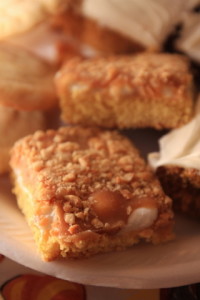
Salted Nut Roll Bars
Salted Nut Roll Bars
These tasty bars are reminiscent of salted nut roll candy bars and come from Maurine Zuetlau of Rockwell City.
1 package yellow cake mix
1 / 2 cup softened margarine
1 egg
3 cups mini marshmallows
2 / 3 cup white corn syrup
1 / 4 cup margarine
1 12-ounce package peanut butter chips
1 cup chopped, dry-roasted peanuts
Combine cake mix, 1 / 2 cup margarine and egg. Pat mixture into 9-inch by 13-inch pan. Bake at 350 degrees for 18 to 20 minutes. Cover bars with marshmallows. Return to oven for 2 to 3 minutes. (Marshmallows will puff up.) Cool.
Boil white corn syrup and 1 / 4 cup margarine. Remove from heat. Add peanut butter chips. Pour mixture over marshmallows and top with nuts. Cool completely, cut into bars.
P.S. Thanks for joining me. I’m glad you’re here.
@Copyright 2016 Darcy Maulsby & Co.
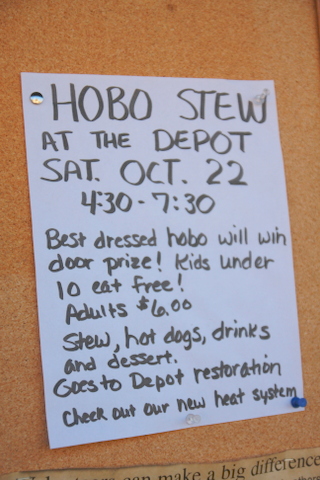
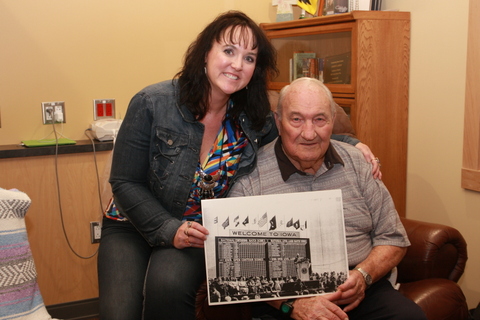
Riding with Harry: 2016 Presidential Election Reflects Truman’s Iowa Revival at 1948 Plowing Match in Dexter
Unpredictable. Shocking. Historic. All have been used to describe the 2016 presidential election, but they also characterized the remarkable presidential election of 1948. Back then, no one thought Harry Truman had any chance of returning to the White House, although he accomplished one of the biggest upsets in U.S. presidential history—and it all started on a farm near Dexter, Iowa.
Bob Larson, an 18-year-old farm boy from Casey, saw it all. “Harry Truman was a farmer, not a politician, at heart,” said Larson, 86, who met Truman on September 18, 1948, at the National Soil Conservation Field Days and Plowing Matches in Dallas County. “We can thank him for the conservation practices that are now common in agriculture.”
A recent high school graduate, Larson was working construction in 1948 with his future father-in-law. The crew was recruited to help build a dam and pond in the conservation demonstration fields north of Dexter. Larson first saw Truman on the afternoon of September 18, when the president jumped off a hayrack at the national plowing matches and headed toward the conservation area. Truman visited with Larson and his friends and family, who were eating lunch under a shade tree.
“Truman said, ‘What the hell are you doin’ just sitting here? Get your dozers started and get back to work. I want to watch you,’” said Larson, who noted that the construction crews had been told to shut down their machines when the president was in the area. “Truman rode with me on my bulldozer for about 10 minutes.”
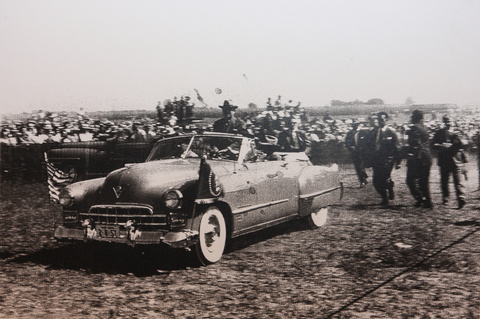
WhenTruman arrived in Dexter on Sept. 18, 1948, he was a 50-to-1 underdog against his presidential rival, New York Governor Thomas Dewey. Nevertheless, a crowd welcomed Truman to Dexter, Iowa, in grand style. As part of his whistle-stop presidential campaign, Truman arrived in Dexter via the Rock Island Railroad, where he was greeted at the depot by the Dexter school band, a parade and a queen and her court. The president, his wife, Bess, and their daughter, Margaret, were escorted to the farm site north of Dexter by a motorcade that included Truman’s convertible limousine.
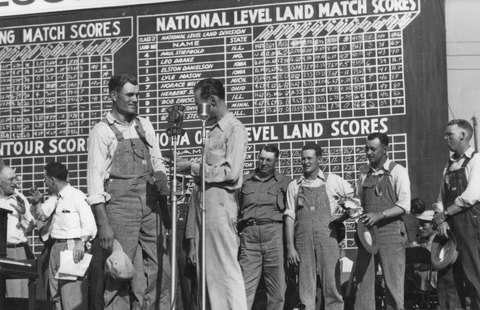
Donald Hanson (left of the radio microphone), a farmer from Roland and competitor at the 1948 National Plowing Matches near Dexter, Iowa, was interviewed on WHO Radio. Hanson is the grandfather of Eric Hanson, a television reporter and anchor on KCCI in Des Moines.
Truman came to Iowa to “Give ‘em Hell”
When Truman arrived in Dexter on Sept. 18, 1948, he was a 50-to-1 underdog against his presidential rival, New York Governor Thomas Dewey. Truman’s appearance in Dallas County stemmed from a White House visit months before when Iowa Farm Bureau President E. Howard Hill and other Iowa ag leaders met with Truman in May 1948 and invited him to come to the National Soil Conservation Field Days and Plowing Matches. The president tried to discourage the men, asserting that they’d have nothing but problems if he and his entourage came.
Dewey was also invited to attend the event but turned the Iowans down flat. “Dewey thought he had the election locked up,” Larson said. “The Midwest didn’t like Dewey, because he was an elitist who had no time for Iowa dirt farmers.”
Months went by with no word from the White House. Then three weeks before the big day, plowing match organizers were notified that Truman had accepted their invitation. Once Dewey heard Truman was headed to Iowa, he immediately arranged for a farm-press event to be held on his Pawling, N.Y., farm on the same day as the national plowing matches near Dexter.
While the media focused on New York, all roads led to the nation’s largest farm event in central Iowa on the September 18, 1948. As the sun rose and the mercury soared, bumper-to-bumper traffic soon clogged the roads near Dexter.
The crowd welcomed Truman in grand style. As part of his whistle-stop presidential campaign, Truman arrived in Dexter via the Rock Island Railroad, where he was greeted at the depot by the Dexter school band, a parade and a queen and her court. The president, his wife, Bess, and their daughter, Margaret, were escorted to the farm site north of Dexter by a motorcade that included Truman’s convertible limousine.
Much to Truman’s delight, a huge crowd of 100,000 people gathered on Lois Agg’s farm to watch the plowing matches, see new conservation practices in action and hear him deliver a speech about farm policy.
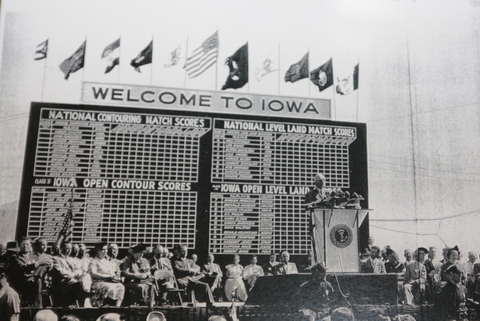
President Harry Truman spoke about farm policy before a crowd of 100,000 people on Sept. 18, 1948, near Dexter, Iowa. This was the first speech that was referred to as “Give ‘Em Hell, Harry,” a slogan that stuck with Truman for the rest of the campaign.
WHO Radio personality Herb Plambeck introduced Truman. During Truman’s 29-minute speech, which was the first major speech of his 1948 presidential campaign, he was interrupted by applause 13 times. The loudest cheers came when he referred to the 80th Congress as the “do nothing Congress.” This was the first speech that was referred to as “Give ‘Em Hell, Harry,” a slogan that stuck with Truman for the rest of the campaign.
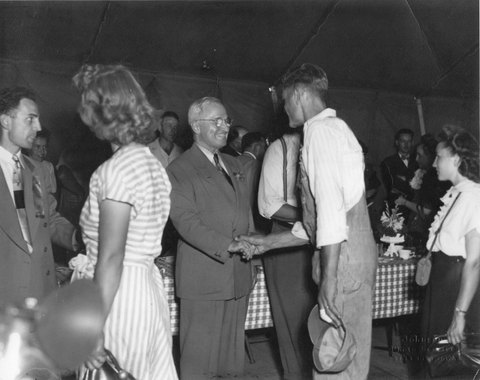
President Harry Truman greeted the crowd at the 1948 National Soil Conservation Field Days and Plowing Matches in Dallas County.
Event ushered in the modern era of ag conservation
After the speech, Truman and his entourage dined on fried chicken before heading out to the demonstration sites to see terraces, ponds and other conservation practices. Truman jumped off the hayrack to get a closer look, as members of the Secret Service scrambled to catch up with him.
“Truman was very interested in soil conservation and asked us a lot of questions,” Larson said. “While some guys thought terraces and contour farming were crazy, many farmers were intrigued by new conservation practices that were being promoted by the Soil Conservation Service.”
Truman took off his suit jacket, rolled up his sleeves on that hot afternoon and continued asking questions as he rode on Larson’s bulldozer while the Secret Service looked on. Larson wasn’t nervous as he chauffeured the president. “Truman was just an old farmer who wanted to know practical things, like how much dirt I was hauling.”
The response Truman received in Dexter that day revitalized his presidential campaign and Truman himself. While the polls still had Truman trailing Dewey on the eve of the 1948 election, and his margin of victory was small, Truman went on to become the 33rd president of the United States.
Truman’s appearance at Dexter also helped usher in the modern era of conservation in agriculture. Larson’s conservation work left a lasting impact, as well, since the dam and pond he built in 1948 are still there. His story, along with photos from that unforgettable day, are preserved at the Dexter Museum and on a historical marker north of Dexter.
“Truman made a good impression on me,” Larson said. “If I’d been old enough to vote in 1948, I probably would have picked Truman.”
Explore more rural Iowa history
Want to discover more stories and pictures that showcase the unique history of small-town and rural Iowa? Check out my top-selling “Calhoun County” book from Arcadia Publishing, and order your signed copy today.
P.S. Thanks for joining me. I’m glad you’re here.
@Copyright 2016 Darcy Maulsby & Co.


